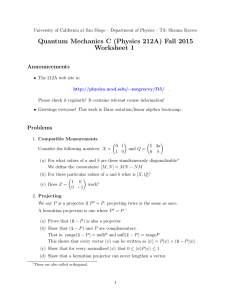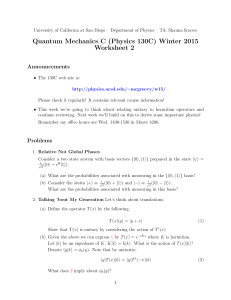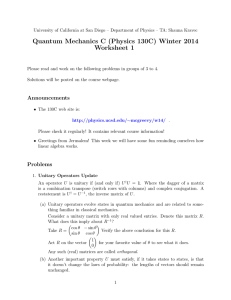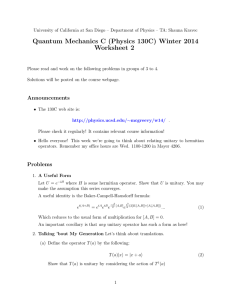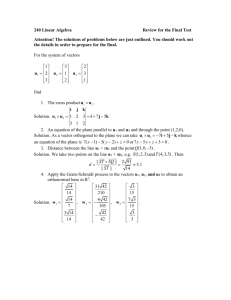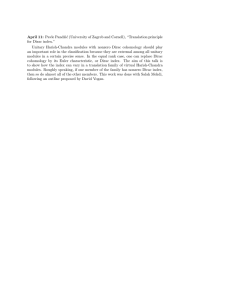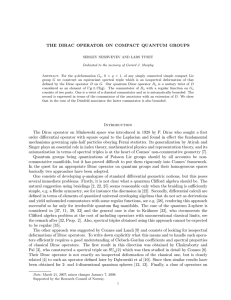Quantum Mechanics C (Physics 130C) Winter 2015 Worksheet 1 Announcements
advertisement
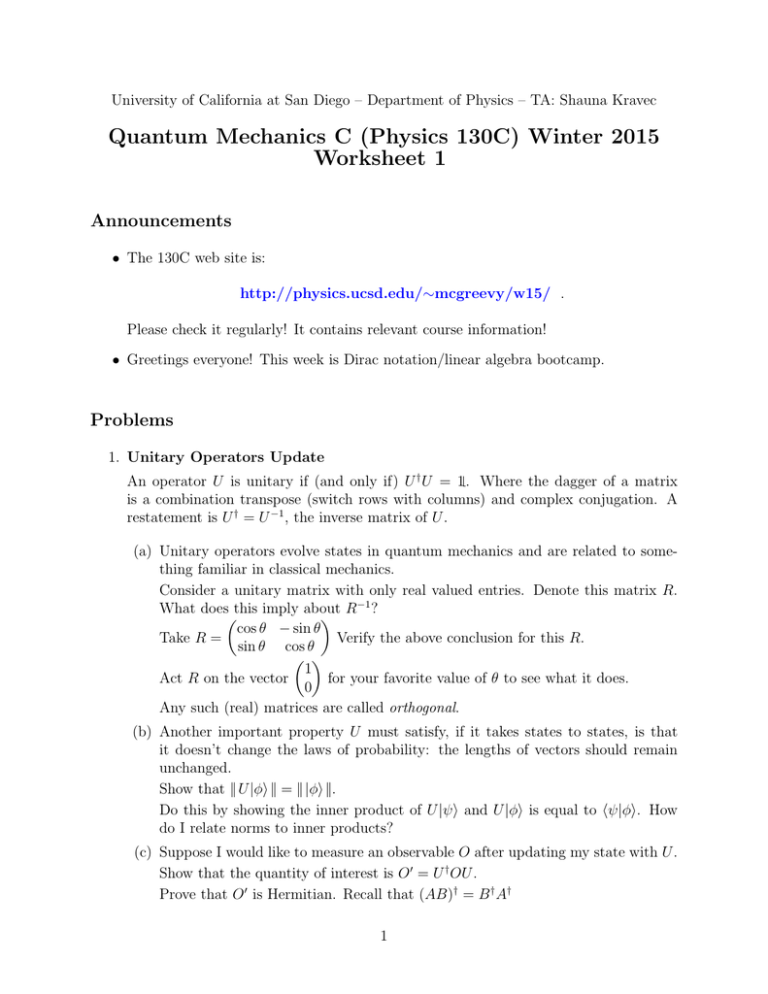
University of California at San Diego – Department of Physics – TA: Shauna Kravec
Quantum Mechanics C (Physics 130C) Winter 2015
Worksheet 1
Announcements
• The 130C web site is:
http://physics.ucsd.edu/∼mcgreevy/w15/ .
Please check it regularly! It contains relevant course information!
• Greetings everyone! This week is Dirac notation/linear algebra bootcamp.
Problems
1. Unitary Operators Update
An operator U is unitary if (and only if) U † U = 1. Where the dagger of a matrix
is a combination transpose (switch rows with columns) and complex conjugation. A
restatement is U † = U −1 , the inverse matrix of U .
(a) Unitary operators evolve states in quantum mechanics and are related to something familiar in classical mechanics.
Consider a unitary matrix with only real valued entries. Denote this matrix R.
What does this imply about R−1 ?
cos θ − sin θ
Take R =
Verify the above conclusion for this R.
sin θ cos θ
1
for your favorite value of θ to see what it does.
Act R on the vector
0
Any such (real) matrices are called orthogonal.
(b) Another important property U must satisfy, if it takes states to states, is that
it doesn’t change the laws of probability: the lengths of vectors should remain
unchanged.
Show that || U |φi || = || |φi ||.
Do this by showing the inner product of U |ψi and U |φi is equal to hψ|φi. How
do I relate norms to inner products?
(c) Suppose I would like to measure an observable O after updating my state with U .
Show that the quantity of interest is O0 = U † OU .
Prove that O0 is Hermitian. Recall that (AB)† = B † A†
1
2. Compatible Measurements
Consider the following matrices: X =
0 1
1 0
5 3a
and Q =
6 b
For what values of a and b are these simultaneously diagonalizable? To solve this first
determine the eigenvectors for X. Then demand these are also eigenvectors of Q.1
We define the commutator [M, N ] = M N − N M
For these particular values of a and b what is [X, Q]?
We say that two observables (Hermitian operators) are compatible if we the order in
which we measure them doesn’t matter.
Translate this to a statement about commutators and diagonalization.
1 0
Does Z =
work?
0 −1
3. Projecting
operator is a projector. We say P is a projector if P 2 = P ;
same as once.
0
and prove P is a projector.
1
x
What is the action on
?
y
0
Show P can be written as the outer product of
and itself.
1
An important type of
projecting twice is the
0
(a) Consider P =
0
(b) Adopting Dirac’s notation let |ii be a normalized (hi|ji = δi,j ) state.
Show that Pi = |iihi| is a projector onto the state |ii. Show it is Hermitian.
What is hj|Pi |ji ?
In this way projectors can represent yes or no questions relating to our system.
4. Represent
Suppose the vectors {|ai, |bi, |ci} form an orthonormal basis for H where some operator
K̂ lives. Suppose we know also that these vectors are eigenvectors of K̂:
K̂|ai = 5|ai K̂|bi = −12|bi K̂|ci = 2i|ci
(1)
(a) Could K̂ represent a physical observable of the system?
(b) Write the matrix K̂ using Dirac notation. Hint: K̂ = a |aiha| + b |bihb| + c |cihc|
(c) Consider |ψi =
√1 (2|ai
2
+ 5i|ci) and compute the expectation or average value of
K̂ in this state defined as hψ|K̂|ψi . Do this using Dirac notation and regular
matrix multiplication.
1
This would not work if either X or Q had repeated eigenvalues though you could still find a basis to
diagonalize both.
2
